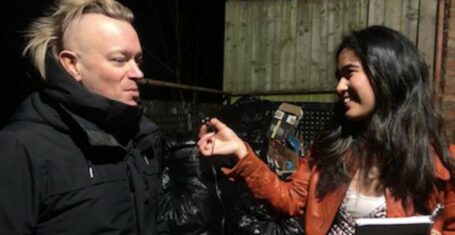
Reviewed: The Odyssey
Dave Spencer enjoys the storytelling of 3DTC’s The Odyssey.
White drapes hang down. A single chair sits on stage, a book resting upon it. The Odyssey is a story, a great story, and the book on the chair makes it clear that John Muething’s production recognises it as such. Just behind the middle drapes, you can glimpse a pile of props and furniture, ready to be used to tell this epic. I settle in to watch this story unwind, told by what seem to be traveling troubadours, as they begin to sing accompanied by the piano.
Despite an occasional lack of energy, the production is fairly strong, the ensemble banding together very well and convincingly. The main weakness, however, comes with the main characters. Athena, the primary storyteller in the first half of the production, is a fairly plain character. Sophia Harrop is consistent with her commanding and authoritative voice but remains emotionless throughout. This fits well with her status as inhuman or immortal, but in a Greek pantheon of famously tempestuous gods, I felt that she could have had a little more of an edge.
This is the main problem with the production. The epic requires epic characters and sadly they are not provided. Telemachus, Odysseus’ son, (played by Chris Blois-Brooke) is introduced early on as a peeved heir to his father’s heroic status, angry with the suitors that are drinking him out of house and home in a pretense to win the hand of his mother, Penelope (Rebecca Wallbank). However, Telemachus, despite being a figure of heroic reputation, did not have the power to really portray the character.
This problem was further compounded by the fact that Daniel Pitts did not suit the character of Odysseus at all, which is a shame in a production centred around him. Mary Zimmerman, the writer of this version of The Odyssey, describes the title character as a “master of improvisation”, which is not even close to the truth.
Before he enters as Odysseus, Pitts is a convincing stock character actor. On the whole, the ensemble did excellently with the enormous task of having to portray such a huge number of characters with only a handful of well-chosen, effective props and costume items. Rebecca Wallbank and Catherine Scutts played a number of characters with ever-changing voices. Nathan Elcox made an excellent Cyclops with the help of a little technical wizardry and Carrie Grant as Calypso was hilarious, sprawling in countless ways at the feet of a particularly camp Hermes. But by far the best character was Will Clarke’s sheep, which definitely deserves a special mention and had me in stitches at what was otherwise a scene in the play I should definitely have been paying more attention to.
On the technical side of things, I would have preferred the rather unnecessary sound to be quieter as I often could not hear what the actors were saying and some of the lighting changes were clunky or did not fit with the situation and change of scene. But overall, the simple technical choices were executed with great effect.
Little rays of brilliance shone through this occasionally patchy production, including a wonderful gimmick with a Trojan horse souvenir, a puppet dog made of a hat and cushion, and a sultry Cell Block Tango-esque siren sequence that had me spinning down feminist labyrinths for a good few minutes after they had returned to their other characters.
Go and see the show if you like The Odyssey. It’s a long production but worth it for those that know what’s going on; though, if you haven’t a clue about the original text, you will struggle to piece together the plot. My advice? Don’t focus on the individual key characters or what is actually going on, but instead appreciate the wonderful ensemble storytelling and craftsmanship of the myriad stock characters that run on and off stage.









































